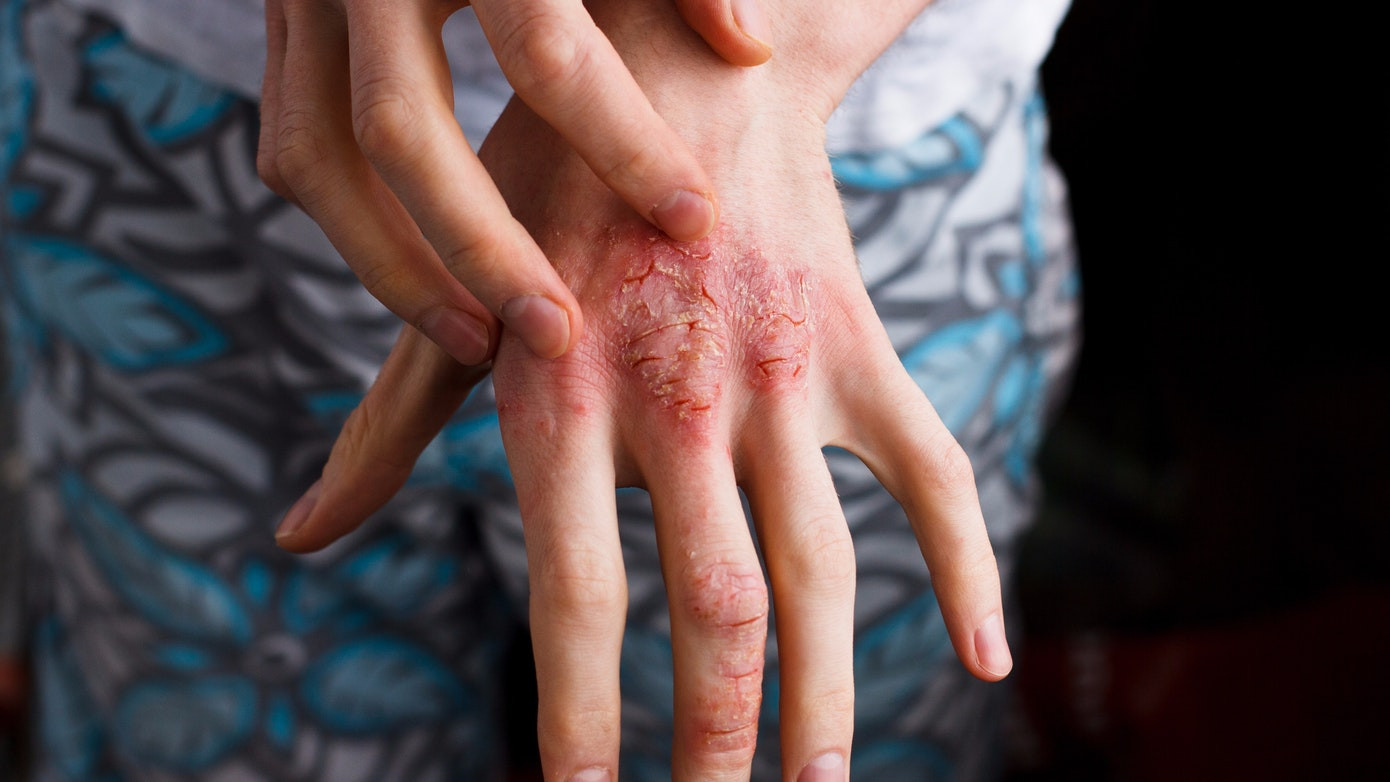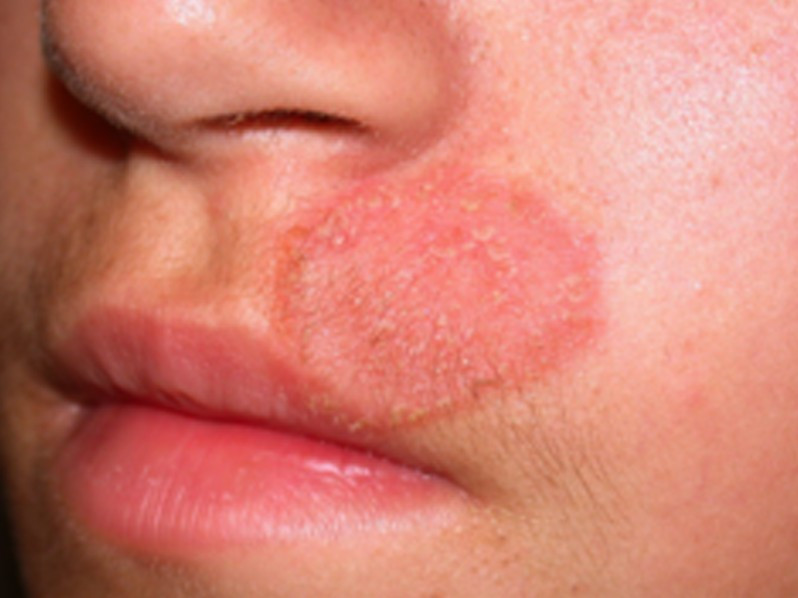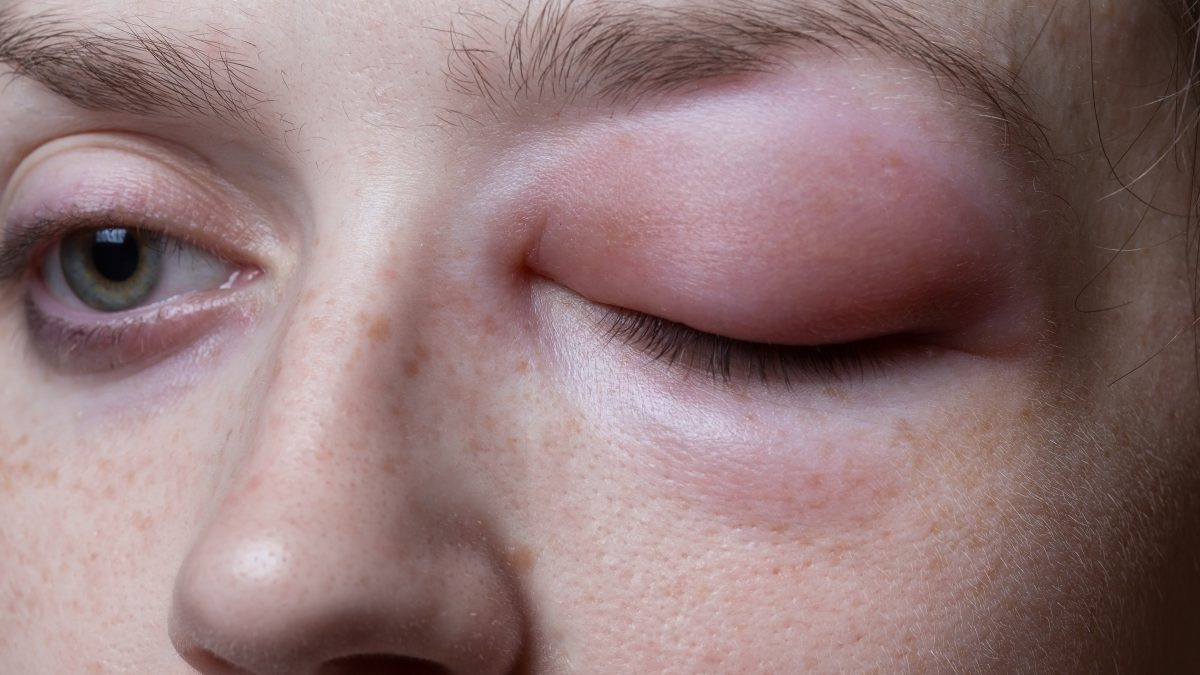Definisi
Dermatitis atopi adalah suatu bentuk peradangan pada kulit yang disebabkan oleh faktor alergi. Dermatitis berasal dari kata "derm" yang berarti "kulit" dan "itis" yang berarti "peradangan", sehingga secara keseluruhan dermatitis berarti "peradangan pada kulit." Kata atopi berasal dari Bahasa Yunani yang memiliki arti “aneh”, dan dalam hal ini berhubungan dengan faktor alergi.
Dermatitis atopi adalah salah satu jenis peradangan kulit yang paling umum terjadi, ditandai dengan bercak merah yang terasa gatal. Bercak-bercak ini umumnya muncul di wajah, lengan, dan kaki. Kondisi ini dapat merusak fungsi kulit sebagai pelindung atau skin barrier (pertahanan tubuh paling luar). Hilangnya fungsi ini akan membuat kulit Anda menjadi lebih sensitif dan lebih rentan terhadap infeksi dan kekeringan.
Dermatitis atopi bukanlah penyakit kulit yang bersifat menular. Gejala dermatitis atopi cenderung akan mengalami kekambuhan (hilang timbul), dan bersifat kronis (berlangsung untuk jangka waktu yang panjang). Kasus dermatitis atopi paling sering terjadi pada anak-anak. Akan tetapi juga dapat mempengaruhi orang dewasa, dan diperkirakan terdapat sekitar 18 juta orang dewasa di dunia yang menderitanya.
Penyebab
Penyebab pasti timbulnya dermatitis atopi belum diketahui. Dermatitis atopi kemungkinan disebabkan oleh kombinasi beberapa hal. Dermatitis atopi dipahami merupakan kondisi peradangan yang timbul sebagai efek dari reaksi alergi yang berlebihan. Reaksi alergi ini menyebabkan terlalu banyak sel radang di kulit, sehingga menimbulkan gejala pada kulit.
Penderita dermatitis atopi sering memiliki kulit yang sangat kering karena kulit mereka tidak mampu mempertahankan kelembapannya. Kekeringan ini dapat membuat kulit cenderung lebih sensitif dan mudah bereaksi terhadap zat, senyawa, atau benda tertentu yang memicu peradangan, sehingga menyebabkan kulit menjadi gatal dan perih.
Faktor genetik juga diduga berperan terhadap timbulnya dermatitis atopi. Anda mungkin memiliki kemungkinan yang lebih tinggi untuk menderita dermatitis atopi karena gen yang diturunkan oleh orang tua pada Anda. Penelitian telah menunjukkan bahwa anak-anak yang memiliki salah satu atau kedua orang tua yang menderita dermatitis atopi, atau saudara kandung dengan penyakit yang sama, lebih mungkin juga untuk menderita dermatitis atopi dibandingkan anak yang tidak memiliki riwayat penyakit dermatitis atopi pada keluarga.
Terdapat beberapa hal yang dapat memicu timbulnya gejala dermatitis atopi dan pemicu ini dapat bervariasi antar individu, seperti:
- Mandi air panas atau berendam terlalu lama
- Goresan benda
- Keringat
- Panas
- Cuaca dingin dan kering
- Sabun, deterjen, dan pembersih
- Wol dan kain sintetis
- Debu, pasir, asap rokok
- Serbuk sari, bulu hewan
- Olahraga berat
- Stres
- Parfum, produk perawatan kulit, dan riasan
- Hormon
- Makanan tertentu (biasanya telur, produk susu, gandum, kedelai, dan kacang-kacangan)
Faktor Risiko
Berikut ini adalah beberapa faktor yang dapat meningkatkan risiko menderita dermatitis atopi, antara lain:
1. Riwayat Alergi
Faktor risiko utama untuk dermatitis atopi adalah memiliki riwayat alergi (dermatitis atopi, asma) baik pada diri sendiri ataupun pada keluarga.
2. Usia
Dermatitis atopi biasanya dimulai pada masa kanak-kanak, tetapi dermatitis atopi dapat ditemukan pada usia manapun.
3. Jenis Kelamin
Perempuan cenderung lebih sering menderita dermatitis atopi dibandingkan laki-laki.
4. Ras
Keturunan Amerika Afrika memiliki risiko yang lebih tinggi untuk menderita dermatitis atopi.
Gejala
Gejala dermatitis atopi paling sering dimulai sebelum usia 5 tahun dan dapat bertahan hingga usia remaja dan dewasa. Pada sebagian kasus, gejala akan muncul secara berkala dan kemudian hilang untuk sementara waktu, bahkan selama beberapa tahun.
Tanda dan gejala dermatitis atopi sangat bervariasi dari orang ke orang. Gejala utama dermatitis atopi adalah kulit kering dan gatal yang sering berubah menjadi ruam merah ketika sedang kambuh. Peradangan pada kulit menyebabkan peningkatan aliran darah dan munculnya keinginan untuk menggaruk. Menggaruk akan terasa sangat melegakan untuk sementara waktu, tetapi dapat menyebabkan peradangan semakin meningkat dan meningkatkan risiko terjadinya infeksi kulit.
Dermatitis atopi memiliki gejala yang berbeda tergantung pada usia, antara lain:
Gejala Pada Bayi
- Kulit kering, gatal, bersisik
- Ruam di kulit kepala atau pipi
- Ruam yang mungkin menggelembung dan mengeluarkan cairan bening
- Bayi mungkin mengalami kesulitan tidur karena kulitnya yang gatal
- Bayi juga dapat mengalami infeksi kulit akibat garukan
Gejala Pada Anak
- Ruam di lipatan siku, lutut, atau keduanya
- Bercak kulit bersisik di lokasi sekitar ruam
- Bintik-bintik kulit yang berwarna lebih cerah atau gelap dibanding kulit sekitarnya
- Kulit tebal dan kasar
- Kulit sangat kering dan bersisik
- Ruam di leher dan wajah, terutama di sekitar mata
Gejala Pada Orang Dewasa
- Kulit yang sangat kering dan bersisik
- Gatal
- Timbulnya ruam di daerah belakang lutut, lekukan siku, belakang leher, wajah, dan di sekitar mata
- Orang dewasa yang menderita dermatitis atopi sejak kecil mungkin memiliki bercak kulit yang berubah warna atau kasar dan mudah teriritasi
Diagnosis
Wawancara
Dalam mendiagnosis dermatitis atopi, dokter akan melakukan wawancara dengan Anda. Dokter akan menanyakan beberapa hal seperti:
- Gejala-gejala yang Anda alami
- Berapa lama gejala tersebut sudah dirasakan
- Lokasi timbulnya ruam
- Riwayat timbulnya gejala yang sama sebelumnya
- Riwayat alergi pada diri Anda atau keluarga Anda
- Kebiasaan-kebiasaan yang dapat memicu timbulnya gejala dermatitis atopi
Pemeriksaan Kulit
Dokter kemudian akan melakukan pemeriksaan fisik dengan melihat secara langsung ruam dengan bantuan kaca pembesar dan lampu. Pemeriksaan kulit bersama dengan informasi tentang kesehatan dan gejala yang Anda alami biasanya sudah cukup untuk menegakkan diagnosis dermatitis atopi. Pada beberapa kasus, dokter juga mungkin akan melakukan pemeriksaan tambahan, seperti:
- Biopsi kulit
Pada pemeriksaan ini, dokter akan membius daerah sekitar kulit yang akan diambil sampelnya. Kemudian dokter akan mengambil sedikit sampel kulit untuk dilihat di bawah mikroskop.
- Tes alergi kulit
Pemeriksaan ini dapat membantu Anda dan dokter mengetahui apakah ruam Anda disebabkan oleh alergi terhadap sesuatu yang Anda sentuh. Sebuah alat seperti plester yang mengandung sejumlah kecil zat pencetus alergi akan ditempelkan di kulit Anda selama beberapa hari. Sekitar 2 hari setelah Anda melepas plester tersebut, dokter Anda akan melihat apakah Anda memiliki ruam di sekitar lokasi bekas tempelan plester.
Tata Laksana
Dermatitis atopi tidak dapat disembuhkan sepenuhnya, tetapi Anda dapat mengurangi gejala yang dialami dan mencegah timbulnya kekambuhan. Cari tahu hal apa saja yang dapat memicu atau memperburuk gejala Anda, agar Anda bisa menghindarinya. Tujuan dari terapi dermatitis atopi adalah untuk mengurangi rasa gatal dan tidak nyaman, serta mencegah timbulnya infeksi dan kekambuhan.
Beberapa langkah yang dapat Anda lakukan adalah:
- Gunakan humidifier jika udara kering membuat kulit Anda menjadi kering
- Melembabkan kulit Anda dengan menggunakan krim atau salep, oleskan beberapa kali sehari, termasuk setelah Anda mandi
- Gunakan air hangat (tidak terlalu panas) untuk mandi
- Gunakan sabun dan produk lain yang bebas dari pewangi, pewarna, dan alkohol
- Gunakan produk kulit yang mengandung Ceramide, pelembap ini dapat memperbaiki fungsi kulit sebagai pelindung kulit
- Konsumsi obat yang diresepkan dokter secara rutin
- Konsultasi dengan psikiater jika Anda mengalami stres atau gejala gangguan mental/emosional yang dapat memicu timbulnya gejala dermatitis atopi
- Fototerapi dengan menggunakan sinar ultraviolet, biasanya ultraviolet B (UVB), dari suatu lampu khusus
Komplikasi
Komplikasi dermatitis atopi mungkin termasuk:
1. Asma
Dermatitis atopi terkadang mendahului munculnya asma. Lebih dari separuh anak kecil dengan dermatitis atopi mengalami asma pada usia 13 tahun.
2. Gatal Kronis dan Kulit Bersisik
Ruam yang gatal akan membuat Anda ingin menggaruknya. Kebiasaan menggaruk dalam jangka waktu yang lama dan terus berulang dapat menyebabkan kulit menjadi berubah warna, tebal dan kasar.
3. Infeksi kulit
Garukan berulang dapat menyebabkan luka terbuka dan retak pada kulit. Hal ini akan meningkatkan risiko infeksi dari bakteri dan virus.
4. Dermatitis Kontak Iritan Pada Tangan
Kondisi ini terutama memengaruhi orang-orang yang pekerjaannya mengharuskan tangan mereka sering basah dan terkena sabun, deterjen, dan desinfektan yang keras.
5. Dermatitis kontak alergi
Kondisi ini umum terjadi pada orang dengan dermatitis atopi. Dermatitis kontak alergi adalah penyakit peradangan kulit yang disebabkan oleh zat kimia reaktif dalam suatu benda yang memicu respon alergi bila berkontak dengan kulit dalam waktu tertentu.
6. Gangguan tidur
Rasa gatal dapat menyebabkan kualitas tidur yang buruk.
Pencegahan
Beberapa cara yang dapat Anda lakukan untuk mencegah timbulnya dermatitis atopi yang berulang, antara lain:
1. Hindari Benda Pemicu
Cari tahu apa yang menyebabkan timbulnya gejala dan cobalah untuk menghindari pemicu tersebut. Misalnya, jika sabun atau kain tertentu menyebabkan timbulnya ruam, hentikan penggunaannya. Cobalah untuk menghindari asap rokok, bulu binatang, dan serbuk sari jika itu membuat kulit Anda lebih buruk.
2. Jaga Kelembapan Kulit
Pilihan terbaik adalah dengan menggunakan krim atau salep yang memiliki sedikit kandungan air. Pakai segera setelah Anda keluar dari kamar mandi atau saat kulit Anda masih basah.
3. Tidak Mandi Terlalu Lama
Batasi waktu mandi Anda hingga 10 menit, dan gunakan air hangat, jangan air panas. Setelah mandi, keringkan kulit Anda dengan handuk lalu segera oleskan pelembap.
4. Gunakan Sabun yang Lembut
Gunakan sabun dengan kandungan zat yang ringan dan lembut pada kulit Anda. Sabun antibakteri memiliki bahan yang bisa mengeringkan kulit Anda.
Kapan Harus ke Dokter?
Konsultasikan diri Anda atau anak Anda ke dokter jika mengalami gejala-gejala yang mengarah ke dermatitis atopi agar mendapatkan diagnosis dan penanganan yang tepat.
Mau tahu informasi seputar penyakit kulit dan rambut lainnya? Yuk, baca lebih banyak artikelnya di sini!
- dr Hanifa Rahma
Atopic Dermatitis (Eczema). (2020). From https://www.mayoclinic.org/diseases-conditions/atopic-dermatitis-eczema/symptoms-causes/syc-20353273 [Accessed March 15, 2022]
Atopic Eczema. (2019). From https://www.nhs.uk/conditions/atopic-eczema/ [Accessed March 15, 2022]
American Academy of Dermatology Association. Eczema Types: Atopic Dermatitis Diagnosis and Treatment. From https://www.aad.org/public/diseases/eczema/types/atopic-dermatitis/atopic-dermatitis-treatment [Accessed March 15, 2022]
Baird, M., et al. Overview of Atopic Dermatitis. (2021). From https://www.healthline.com/health/atopic-dermatitis/what-is-atopic-dermatitis [Accessed March 15, 2022]
Bhargava, HD. Atopic Dermatitis. (2020). From https://www.webmd.com/skin-problems-and-treatments/eczema/eczema-basics [Accessed March 15, 2022]
Cole, GW. Atopic Dermatitis Symptoms, Causes, vs. Eczema, Remedies, and Treatment. (2021). From https://www.medicinenet.com/atopic_dermatitis/article.htm [Accessed March 15, 2022]
Eczema. (2020). From https://my.clevelandclinic.org/health/diseases/9998-eczema [Accessed March 15, 2022]
Kolb, L., et al. Atopic Dermatitis. (2021). From https://www.ncbi.nlm.nih.gov/books/NBK448071/ [Accessed March 15, 2022]












